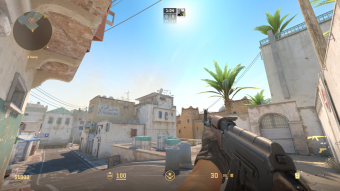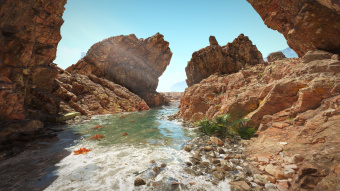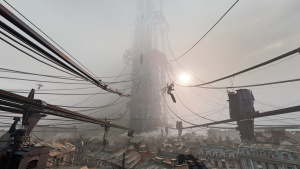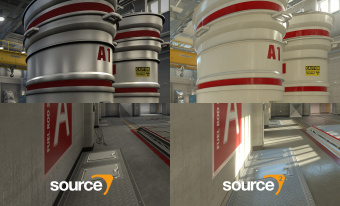Source 2


![]() Source 2 is a 3D video game engine developed by Valve as a successor to Source.
Introduced in 2015, it is used in most Valve games since the release of Dota 2, including Half-Life: Alyx, Counter-Strike 2, Deadlock, and many more.
Source 2 is a 3D video game engine developed by Valve as a successor to Source.
Introduced in 2015, it is used in most Valve games since the release of Dota 2, including Half-Life: Alyx, Counter-Strike 2, Deadlock, and many more.
Development of Source 2 was planned after the release of Half-Life 2: Episode Two and other The Orange Box games. In 2010, Left 4 Dead 2 was privately ported to the Source 2 engine as a tech demo, with one of the maps recreated in the Source 2 engine. The engine was later made public with the Dota 2 Workshop Tools Alpha in August 6th 2014 and formally announced by Valve in March of 2015 at the Game Developers Conference. It was then implemented into Dota 2 on June 17th 2015, and finally publicly released in September 2015. Valve has announced that Source 2 will be released to the public for free, and it will only take money should it be used for commercial products. Despite this, unlike its predecessor, Source, the Source 2 engine was rarely licensed to any third-party game developers, aside from Facepunch Studios's S&box.
The engine is capable of rendering highly complex and well detailed scenes with minimal framerate drops, thanks to its new 64-bit support, new VIS method, alongside Vulkan, Direct3D 11, allowing for better multi-core rendering, better graphics and more efficient 3D rendering.
Features
Renderer
- Support MSAA, FXAA and TAA anti-aliasing
- Source 2 supports various anti-aliasing techniques, each with their own advantages & disadvantages. For more information, see anti-aliasing page.
- Native DirectX 11® and Vulkan® support, with Shader Model 5.0 and later.
- Add various new rendering features that previous renderer used in Source (Direct3D 9) doesn't have.
- Support for both forward and deferred rendering pipelines.
- Deferred rendering is a rendering technique that allow games to render as much lights with little performance impact. Deferred rendering are commonly used in most modern titles.
- Games such as Counter-Strike 2 and Half-Life: Alyx uses forward renderer, while Deadlock and Dota 2 uses deferred renderer.
- Cascaded Shadow Maps
- Real-time dynamic shadows from skybox.
- Screen Space Ambient Occlusion support
- Simulate soft shadows on area such as walls and other objects by examining an onscreen pixel, and then comparing its location in a depth buffer to the pixels around it.
- Phong and Cook-Torrance[confirm][citation needed] shading model
- Physically Based Rendering support
- PBR render graphics in a way that more accurately models the flow of light in the real world.
- Volumetric lighting support.
- Improved cubemap reflections
- Source 2 cubemaps, by default, are in higher resolutions compared to Source. Cubemaps in Source 2 are also parallax corrected.
- WebM
- Source 2 uses WebM video, replacing the previous Bink Video format. This will allow in-game intro and cutscenes to take less storage space as WebM provides better compression compared to Bink. WebM is also a open-format compared to Bink video.
- Volumetric smokes (only in
 )
) - Smokes are now volumetric objects, that can be interacted by grenades, bullets, and more. It also react to lighting and the smokes fill the spaces naturally.
Physics
- Rubikon
- Valve's new in-house physics engine, replaced Havok previously used in Source to reduce licensing costs. Includes support for Cloth Simulation.
Sound System
- Steam Audio
- Valve's new in-house sound system licensed under Apache 2.0 license, replaces proprietary Miles Audio System.
- Improved Steam Audio
- Sounds have been reworked to better reflect the physical environment, be more distinct, and express more game state. They have also been rebalanced for a more comfortable listening experience.
- Other audio improvements
- Improved audio and voice processing.[Clarify]
Networking
- Sub-tick system (in all games since
 )
) - Tick rate no longer matters for moving, shooting, or throwing.
UI
- Panorama
- Valve's new Custom GUI interface that resembles modern web design and authoring (HTML5/CSS/JS). Using .XML and JavaScript files, developers can create dynamic and clean HUDs and menus and even high-quality in-game interactable panels.
- Scalable across any resolution, compared to VGUI used in previous Source games (prior to Left 4 Dead) which would become small if the game is running at higher resolution.
Tools
- Integrated asset management via the Asset System.
- New engine-integrated authoring tools, rebuilt from the ground up.
- All compiling tools except VRAD are now merged into one. The map compiling tool are named as Resourcecompiler.
- All Source 2 engine tools can be launched from
 Asset Browser. It is similar to the now-deprecated Source SDK Launcher and Authoring Tools previously used in Source engine.
Asset Browser. It is similar to the now-deprecated Source SDK Launcher and Authoring Tools previously used in Source engine.  Hammer 5.x
Hammer 5.x- Completely rebuilt Hammer level editor, featuring modern polygon mesh editing tools.
- Hardware accelerated ray-tracing for VRAD
- Currently supports all NVIDIA RTX and AMD RX 6000 series (or later), and other RDNA2 GPU only. Intel Arc not supported yet.
- VRAD3 now requires graphics card with ray-tracing support to preview & bake lighting. This will allow VRAD to quickly calculates lighting data.
- VRAD3 is supported in all Source 2 games since 2022. Some games such as Half-Life: Alyx and SteamVR Home still provides previous version (VRAD2) for users who want to compile maps lighting on systems that does not support hardware accelerated ray-tracing.
Programming
- 64-bit support
- Faster game performance, and allowing game to access over 4 GB of RAM. Previously, Source 2 also support 32-bit, which has been dropped with the release of
 Dota 2 update in 2021 (except
Dota 2 update in 2021 (except  SteamVR Home).
SteamVR Home).
Other
- Replaced brushes (BSP) with meshes (
.vwnod_c) - BSP and Brushes (from Source, which goes back to Quake and Quake II), has been replaced with meshes, and BSP is replaced with octree (
.vwnod_c) for geometry partitioning. Brush entities has been also replaced with mesh entity. - Improved VIS
- Source 2's VIS works differently than Quake, GoldSrc and Source Visleaf system.
Limitations
Newer games like Counter-Strike 2 will also require a CPU with SSE 4.2 support.
Products using Source 2 



Valve
Products made by Valve.
Released
| Release date | Title | Co-developed with | Platforms | Notes |
|---|---|---|---|---|
| 9 Jul 2013 | |
PC: Windows, Mac, Linux | A MOBA game. Sequel to 2003's Warcraft III mod, Defense of the Ancients (retroactively called as Dota 1, DotA for short). Originally using Source when launched in 2013, ported to Source 2 in Sep 9, 2015. | |
| 22 Feb 2016 | SteamVR Performance Test | PC: Windows (VR) | Non-interactive version of the Robot Repair demo. No longer available for download. | |
| 5 Apr 2016 | |
PC: Windows (VR) | This is the only |
|
| 9 Jun 2016 |
|
PC: Windows, Linux (VR) | Photogrammetry and environment viewer. Deprecated and replaced by SteamVR Home. | |
| 19 May 2017 | |
PC: Windows, Linux (VR) | Virtual Reality portal and social hub included as part of SteamVR. | |
| 28 Nov 2018 | |
PC: Windows, Mac, Linux | The Dota Card Game. The game was widely criticized by players who are disappointed with Valve abandoning the Half-Life series at the time, aswell as calling the game "pay-to-win", even prior to Artifact being released. | |
| 20 Jun 2019 | |
PC: Windows, Mac, Linux Mobile: Android, iOS |
Auto Battler game. This is currently the only Source 2 games to be released on mobile devices (both Android, iOS). | |
| 23 Mar 2020 | |
PC: Windows, Linux (VR) | First Half-Life game to be released since the release of Half-Life 2: Episode Two, which was released 12 years prior. Half-Life: Alyx was highly anticipated when it was announced. | |
| 2 Mar 2022 | |
PC: Windows, Linux | A short playable demo set in Portal universe, used to demonstrate the Steam Deck. The game requires controller to play the demo. | |
| 27 Sep 2023 | |
PC: Windows, Linux | Originally planned to be released in Summer 2023, it was delayed and later released in September 27, 2023. This is a port of Counter-Strike: Global Offensive to the Source 2 engine, under it's new name " |
Unreleased
This section are for unreleased games by Valve that are in development, not publicly released or is in Beta/Early Access.
| Release date | Title | Developer(s) | Publisher(s) | Platforms | Notes |
|---|---|---|---|---|---|
| TBA | |
Valve | Valve | PC: Windows | Deadlock is a third-person shooter MOBA game currently in semi-private beta testing (invite only). The game features 21 characters you can play as. It is known internally as "Project 8" and formerly "Citadel". Players who already have access to Deadlock can invite another player(s) to have beta access. |
Third-Party
Products made by third-party companies and mod teams.
Released
- None yet.
In development/Unreleased
This section are for unreleased 3rd party games that are in development, not publicly released or is in Beta/Early Access.
| Release date | Title | Developer(s) | Publisher(s) | Platforms | Notes |
|---|---|---|---|---|---|
| TBA | |
Facepunch Studios | Facepunch Studios | PC: Windows (VR optional) | As stated by Garry Newman himself, this is not intended to be a remaster of Garry's Mod, but rather, a spiritual successor. This is also the first time, and only time Source 2 was licensed to third-party developer. S&Box runs on heavily modified version of Source 2. |
Documentation
See also


